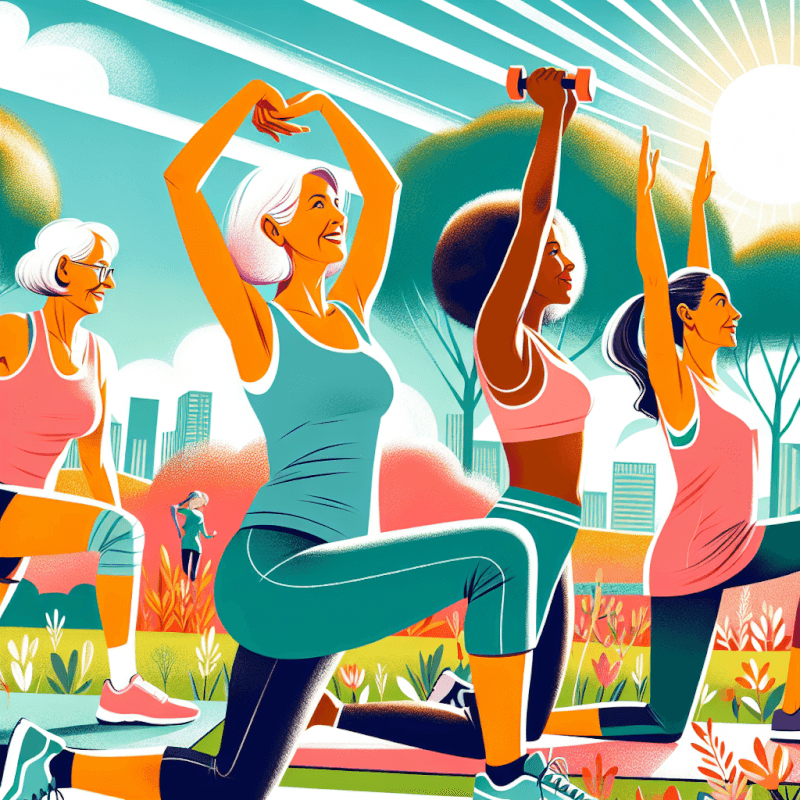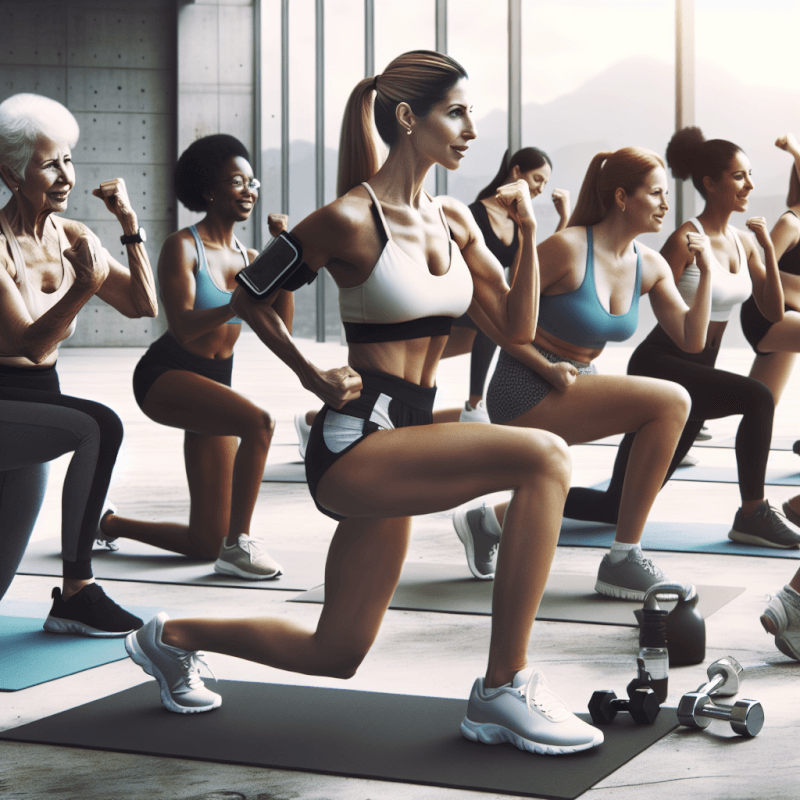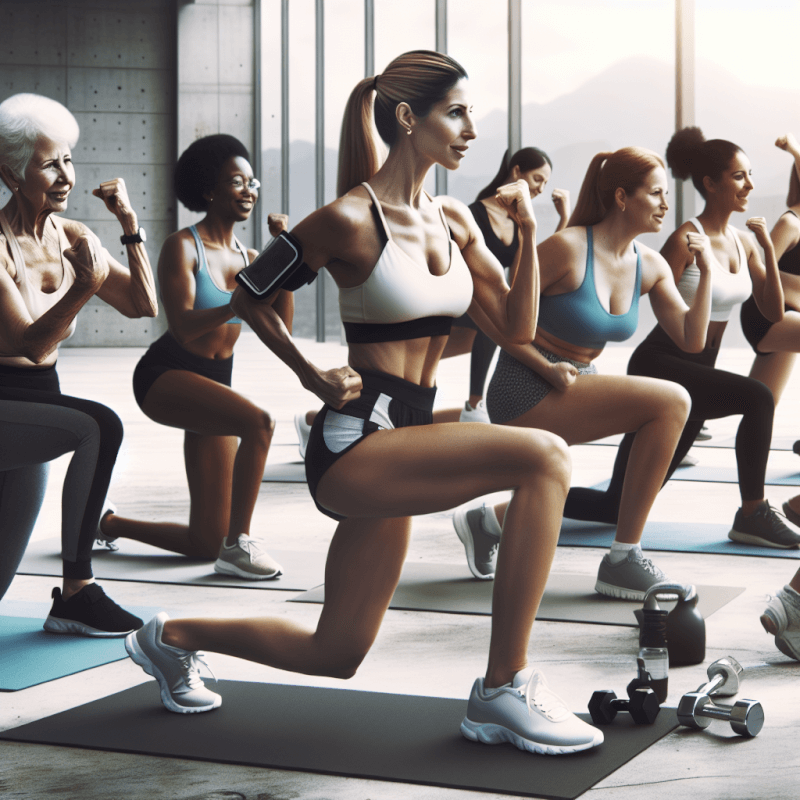Are you a woman over 50 looking to start an exercise program but unsure where to begin? Look no further! We have designed a comprehensive exercise program specifically tailored to meet the unique needs and goals of women in this age group. Whether you are new to exercise or have been active throughout your life, this program is designed to help you increase your strength, improve your cardiovascular fitness, and enhance your overall well-being. With a variety of exercises targeting different muscle groups and fitness levels, you can customize your workouts to suit your individual needs and preferences. Get ready to embark on a journey towards a healthier and more active lifestyle with our exercise program for over 50 females.

Benefits of Exercise for Women Over 50
Maintaining an active lifestyle becomes increasingly important for women over 50. Regular exercise offers numerous benefits that can improve your overall health and well-being. Here are some key advantages of staying physically active:
Improved Cardiovascular Health
Engaging in cardiovascular exercises, such as brisk walking, cycling, swimming, or dancing, can greatly benefit your heart health. These activities increase your heart rate, strengthen your heart muscle, and improve blood circulation. Regular aerobic exercise can lower the risk of cardiovascular diseases, such as heart attacks and strokes, as well as help manage blood pressure and cholesterol levels.
Increased Bone Density
As women age, their bone density tends to decline, increasing the risk of osteoporosis and fractures. However, participating in weight-bearing exercises, like strength training and some cardiovascular activities, can help slow down this loss. By putting pressure on your bones, these exercises stimulate bone cell growth and enhance bone density. This can lower the risk of fractures and improve overall bone health.
Enhanced Flexibility and Balance
Flexibility exercises, such as yoga, Pilates, and stretching exercises, help improve and maintain joint mobility and muscle flexibility. This can reduce the risk of injuries and make daily tasks easier. Additionally, performing balance exercises like tai chi, single leg stands, and heel-to-toe walks can enhance stability and coordination, reducing the risk of falls.
Factors to Consider Before Starting an Exercise Program
Before starting any exercise program, it is essential to consider certain factors that can impact your safety and success. Taking these factors into account will help you develop a program tailored to your needs and abilities. Here are some factors to consider:
Consulting a Healthcare Professional
It’s always a good idea to consult with your healthcare professional before starting a new exercise program, especially if you have any pre-existing health conditions or concerns. They can evaluate your current health status, provide advice on suitable exercises, and inform you of any limitations or precautions you should take.
Identifying Any Existing Health Conditions
Knowing your current health condition allows you to adapt your exercise program accordingly. If you have chronic conditions like heart disease, arthritis, or diabetes, your exercise routine may need specific modifications. Work with your healthcare professional to determine any limitations or exercise preferences based on your health status.
Setting Realistic Goals
Setting realistic and achievable goals is an important aspect of a successful exercise program. Consider what you hope to achieve and set specific targets to track your progress. It could be increasing your endurance, improving strength, or simply feeling more energized throughout the day. Setting realistic goals will help you stay motivated and avoid disappointment.

Types of Exercise for Women Over 50
There are various types of exercises you can incorporate into your routine to achieve a well-rounded and effective program. Here are four key types of exercises that are particularly beneficial for women over 50:
Cardiovascular Exercises
Cardiovascular exercises, also known as aerobic exercises, focus on increasing your heart rate and improving your cardiovascular fitness. Examples of cardiovascular exercises include brisk walking, cycling, swimming, and dancing. These activities strengthen your heart, improve lung capacity, and boost endurance.
Strength Training
Strength training involves using resistance to build muscle strength, improve bone health, and increase metabolism. Bodyweight exercises, such as squats, push-ups, and lunges, can be effective for strength training. Additionally, incorporating resistance training with resistance bands or weightlifting can provide further benefits. Strength training helps maintain and build muscle mass, benefiting overall health, and bone density.
Flexibility Exercises
Flexibility exercises aim to enhance joint mobility, muscle elasticity, and overall flexibility. Activities like yoga, Pilates, and dedicated stretching exercises can help improve your range of motion, reduce muscle stiffness, and promote relaxation. Flexibility exercises can be particularly beneficial for preventing injuries and maintaining mobility as you age.
Balance Exercises
Balance exercises specifically target your stability and coordination, reducing the risk of falls. Tai chi, single leg stands, and walking heel-to-toe are excellent examples of balance exercises. By practicing these exercises regularly, you can improve your balance, agility, and overall physical performance.
Cardiovascular Exercises
Cardiovascular exercises are excellent for strengthening your heart, boosting endurance, and improving overall cardiovascular fitness. Here are some popular cardiovascular exercises suitable for women over 50:
Brisk Walking
Brisk walking is a low-impact exercise that can be easily incorporated into your daily routine. Whether you walk outdoors or on a treadmill, aim for a pace that elevates your heart rate and leaves you slightly breathless. Start with shorter durations and gradually increase your walking time to challenge your cardiovascular system.
Cycling
Cycling, whether indoors on a stationary bike or outdoors, is a fantastic cardiovascular exercise. It is gentle on the joints while providing aerobic benefits. Consider joining a cycling group or exploring local bike trails to make your cycling workouts more enjoyable.
Swimming
Swimming is a non-weight-bearing exercise that puts minimal stress on your joints while providing a full-body workout. It is an excellent choice if you have joint pain or arthritis. Whether you swim laps or participate in aqua aerobics classes, swimming helps improve cardiovascular fitness and overall muscle strength.
Dancing
Dancing is a fun and social way to get your heart pumping. Joining dance classes like Zumba, salsa, or ballroom dancing can provide an excellent cardiovascular workout while allowing you to express yourself and enjoy the music. Dancing also helps improve coordination and balance, which are essential for overall physical well-being.

Strength Training Exercises
Including strength training exercises in your routine can help improve muscle strength, prevent muscle loss, and enhance overall physical performance. Here are some types of strength training exercises suitable for women over 50:
Bodyweight Exercises
Bodyweight exercises are great for building strength without the need for additional equipment. They use your body weight as resistance. Examples of bodyweight exercises include squats, lunges, push-ups, planks, and tricep dips. You can modify these exercises based on your abilities and gradually increase the intensity as your strength improves.
Resistance Training
Resistance training involves using equipment like resistance bands or machines to provide added resistance during your exercises. These tools can help target specific muscle groups and increase the challenge. Resistance training not only strengthens muscles but also improves bone density and metabolism. Consider working with a fitness professional to learn proper form and tailor exercises to your needs.
Weightlifting
Weightlifting involves using free weights, like dumbbells or barbells, to engage multiple muscle groups simultaneously. It is an effective way to build overall strength and increase bone density. Begin with lighter weights and gradually progress to heavier weights as you become more comfortable and confident with your form. Proper technique is crucial to prevent injuries, so consider seeking guidance from a fitness professional.
Flexibility Exercises
Flexibility exercises are essential for maintaining good joint mobility, preventing muscle imbalances, and reducing the risk of injuries. Here are some types of flexibility exercises suitable for women over 50:
Yoga
Yoga combines physical postures, breathing exercises, and meditation to promote flexibility, strength, and relaxation. It is a low-impact activity that suits people of all fitness levels. Various forms of yoga, such as Hatha, Vinyasa, or Yin, offer different focuses and intensity levels. Find a yoga class or follow online tutorials that cater to beginners or those specifically for women over 50.
Pilates
Pilates focuses on core strength, flexibility, and muscular control. It incorporates a combination of exercises performed on a mat and specific Pilates equipment, like the reformer. Pilates exercises target the muscles of the abdomen, back, hips, and pelvis. Engaging in Pilates can help improve posture, balance, and overall body awareness.
Stretching Exercises
Dedicated stretching exercises can help improve flexibility and reduce muscle stiffness. Perform stretches for major muscle groups like your legs, hips, back, chest, shoulders, and arms. Aim to hold each stretch for 15-30 seconds and gradually deepen the stretch over time. Incorporate stretching exercises into your warm-up and cool-down routines for the best results.

Balance Exercises
Maintaining good balance is crucial for preventing falls and maintaining independence as you age. Here are some types of balance exercises suitable for women over 50:
Tai Chi
Tai Chi is a gentle martial art that combines slow, flowing movements with deep breathing and mental focus. It improves balance, coordination, and muscle strength. Tai Chi classes are widely available and can provide a supportive group environment to practice and learn the movements effectively.
Single Leg Stands
Practicing single leg stands can help improve your balance and strengthen the muscles involved in maintaining stability. Stand near a wall or sturdy surface for support, then lift one leg slightly off the ground and hold the position for 30 seconds. Switch legs and repeat. As you progress, try performing the exercise without support.
Heel-to-Toe Walk
The heel-to-toe walk, also known as the tandem walk, is a simple yet effective balance exercise. Walk in a straight line, placing the heel of one foot directly in front of the toes of the other foot with each step. Engaging in this exercise helps improve your balance and coordination.
Creating an Exercise Plan
Designing an exercise plan that suits your specific needs and preferences is crucial for long-term success. Consider the following factors when developing your personalized exercise plan:
Setting a Schedule
Determine the days and times you will dedicate to exercise. Consistency is key, so choose a schedule that is realistic and manageable for you. Aim for at least 150 minutes of moderate-intensity aerobic activity per week, along with strength training exercises two or more days a week. This can be broken down into smaller, more manageable sessions.
Choosing a Variety of Exercises
Incorporate a variety of exercises into your routine to keep it interesting and engage different muscle groups. This might include a combination of cardiovascular exercises like brisk walking and swimming, strength training exercises using bodyweight and resistance, flexibility exercises like yoga and Pilates, and balance exercises like tai chi. Mixing it up will prevent boredom and help you reap the benefits of a well-rounded program.
Progressing Gradually
Start with exercises that are appropriate for your fitness level and gradually increase the duration, intensity, or difficulty as your fitness improves. It’s important to listen to your body and avoid pushing yourself too hard. Increase the challenge gradually to avoid injury and ensure long-term sustainability.

Safety Tips for Exercising
Safety is paramount when engaging in any exercise routine. Here are some essential safety tips to consider:
Warming Up and Cooling Down
Always warm up your body before starting an exercise session. This can involve gentle movements and stretches to increase blood flow to your muscles. After exercising, cool down with stretches to promote recovery and reduce muscle soreness. Warming up and cooling down properly can help prevent injuries.
Using Proper Form
Perform exercises with proper form to maximize their benefits and avoid strain or injury. If you are unsure about the correct technique, consider working with a fitness professional who can provide guidance and instruction. Pay attention to your posture and ensure you understand the appropriate body alignment for each exercise.
Listening to Your Body’s Cues
Pay attention to your body’s signals. If you experience pain or discomfort during exercise, modify or stop the activity. It’s normal to feel some muscle fatigue or soreness, but sharp or persistent pain should be addressed. Stay hydrated, take breaks when needed, and rest if you feel overly fatigued.
Motivation and Support
Staying motivated and having a support system can greatly enhance your exercise journey. Consider the following strategies to boost your motivation and find support:
Finding a Workout Buddy
Exercising with a friend or family member can make workouts more enjoyable and increase accountability. Having someone to share your progress, setbacks, and achievements with can provide valuable support and encouragement along the way.
Joining Fitness Classes or Groups
Joining fitness classes or groups can provide a sense of community and make exercise a social activity. Look for classes specifically designed for women over 50 or groups with similar fitness goals. Participating in group activities can be motivating, inspiring, and provide opportunities to make new friends.
Tracking Progress and Celebrating Milestones
Keep track of your exercise progress by maintaining a workout journal or using a fitness tracking app. Seeing how far you’ve come can boost your motivation and provide a sense of accomplishment. Celebrate milestones along the way, whether it’s completing a certain number of workouts or reaching a specific fitness goal. Rewarding yourself for your achievements can help maintain a positive mindset and reinforce healthy habits.
In conclusion, regular exercise offers numerous benefits for women over 50, including improved cardiovascular health, increased bone density, enhanced flexibility, and better balance. By considering factors such as consulting a healthcare professional, identifying existing health conditions, and setting realistic goals, you can create an exercise program tailored to your individual needs. Incorporating various types of exercises, such as cardiovascular, strength training, flexibility, and balance exercises, will help you achieve a well-rounded and effective routine. Remember to prioritize safety by warming up, using proper form, and listening to your body’s cues. Additionally, finding motivation and support through workout buddies, fitness classes/groups, and tracking progress can enhance your exercise experience. Start today and reap the wonderful benefits of exercise for women over 50!


